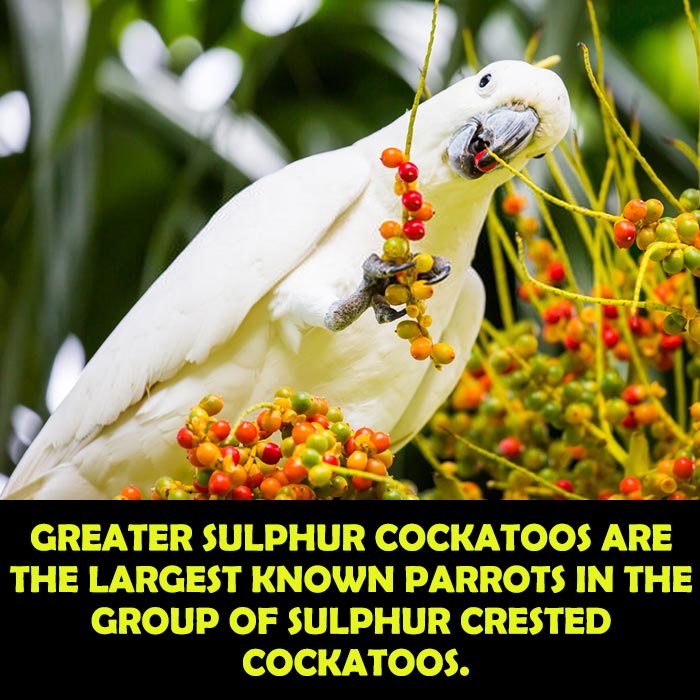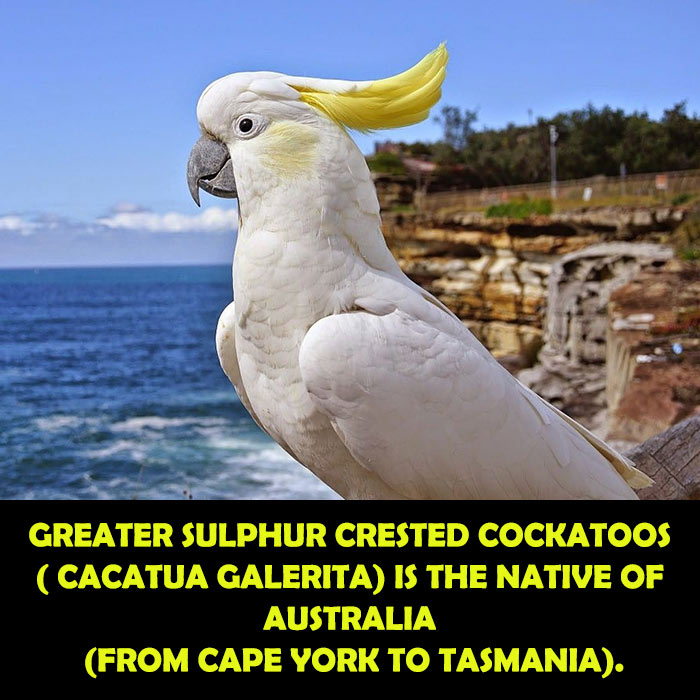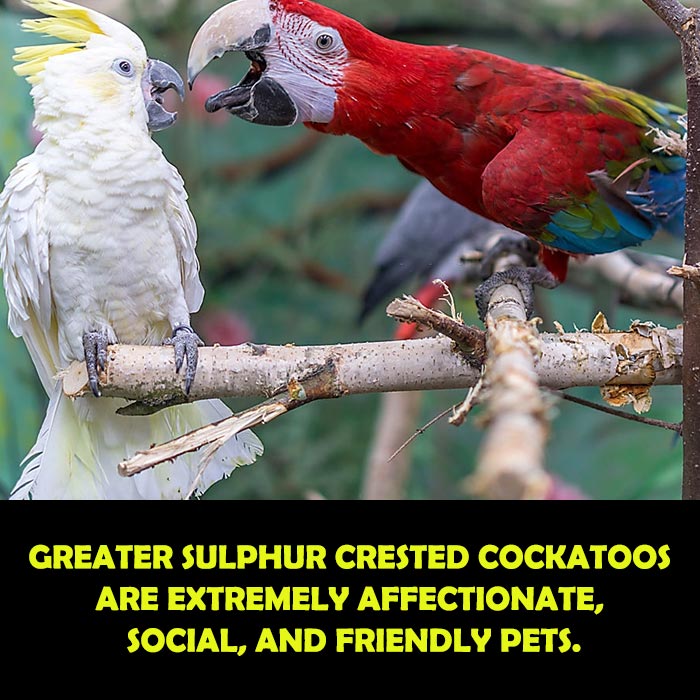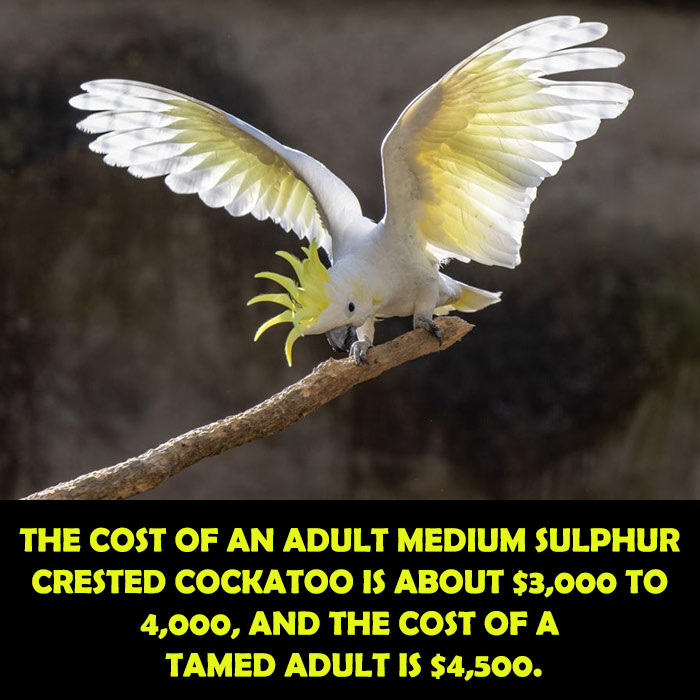Greater Sulphur Crested Cockatoo (Cacatua Galerita) is the largest subspecies of Sulphur Crested cockatoos. They are adorable white-feathered parrots and spread over the wide range of Australia. Greater Sulphur Crested Cockatoos are very affectionate and friendly parrots. They are intelligent and quick responders to actions.
They have many similarities with all subspecies of Sulphur Crested cockatoo but their size is bigger than others. Their expressive yellow crest on the head is the most unique feature of these parrots.
They are high-demand parrots in Aviculture. This species has been introduced to the Islands of Indonesia and New Zealand in order to maintain its growth rate. They are very charming parrots, their behavior, lifespan, breed, and appearance, etc will be discussed in this article in detail.
Greater Sulphur Crested Cockatoo:
Greater Sulphur Cockatoos are the largest known parrots in the group of Sulphur Crested Cockatoos. If we observe their physical traits they resemble Yellow Crested Cockatoo and opposite to Moluccan Cockatoos. They are very well-known pets because it is very easy to tame these parrots.
These parrots have beautiful White plumage like all subspecies of Sulphur Crested Cockatoos have. They have prominent yellow crests, which can be raised and lowered. They use the movement of their crest in order to communicate with their fellows.
They also indicate any danger and alarming expression by their crest and when they want to scare someone they raise their crests. In order to make a defense for themselves, they raise their crests. They have a very attractive, playful, and talkative personality.
These parrots are mostly active in the morning or in the afternoon. They are attention seekers, and if they are not attended to properly by their owners they become destructive and noisy.

Scientific Classification of Greater Sulphur Crested Cockatoo:
- Scientific Name: Cacatua Galerita
- Common Name: Greater Sulphur Crested Cockatoo
- Order: Psittaciformes
- Class: Aves
- Kingdom: Animalia
- Genes: Cacatua
- Species: C.Galerita
- Phylum: Chordata
- Family: Cacatuidae
What Does Greater Sulphur Crested Cockatoos Look like?
Greater Sulphur Cockatoos are large parrots with the size of about 50 to 55 cm and their weight is 700 to 950 grams. They are grateful large parrots with adorable white plumage. The beak of Greater Sulphur Crested Cockatoo is hooked and it is dark Black in color. Their beaks are small and powerful.
They have big white feathered bodies, and they have sulfur yellow markings on their body. They have yellow tinge underwings and tails. These parrots have graceful yellow crests on the upper side of the head. Their feet are Zygodactylous, and these feet have two toes.
Two toes are pointed forward, and the other two toes are pointed backward. They are dark Black in color and they have dark black legs. They have large wingspan and many people like their pure white iconic appearance. Mainly Male and Female Greater Sulphur Crested Cockatoos look similar but there are some differences also.
Difference in Appearance of Male and Female Greater Sulphur Crested Cockatoo:
The major difference between males and females is the color of their eyes. They have very minute differences which can be observed if seen properly. Male eyes are darker than females. The Male has dark black eyes and the female has reddish-brown eyes.
Where Do Greater Sulphur Crested Cockatoos live?
Greater Sulphur Crested Cockatoos ( Cacatua Galerita) is the native of Australia (from cape york to Tasmania). They have a wide range of habitats. They are the least concerned species, and they can be easily found in several areas of Australia.
They inhabit dense forests and woodlands. Their habitat is in Tasmania, Victoria, New South Wales, to Northern (Queensland). They are also found in Western Australia, from Northern territory to the Kimberly area. They are mostly found in islands, forests, and woodlands of Australia.

In order to protect the population of these beautiful parrots, there are many protection programs. Their species has been introduced in Indonesia (Palu Island) and Perth, and New Zealand, etc. Efforts are going on to maintain their growth rate and to save these species from decline.
They can also do very well in captivity, they are well adapted to urban settlements. These parrots are adorable home pets and they need a large cage for living. They love to live with their owners and their favorite persons,
Size and weight of Greater Sulphur Crested cockatoo:
Greater Sulphur Crested Cockatoos are the largest parrot subspecies of Sulphur crested cockatoo among all. Their iconic large appearance made them Greater sulphur cockatoo. They are 50 to 55cm long and weigh about 700 to 950 grams.
Vocals of Greater Sulphur Crested cockatoos:
Greater sulphur Crested Cockatoos are very intelligent and noisy parrots. They make very Raucous (loud) calls which are very distinctive. They produce these calls when they are in Alarming Situations (danger) or annoyed. During their flight, they produce loud calls and communicate with their fellows.
They can mimic vocals, sounds of animals and humans and can learn many words and phrases. They are also good at making whistling sounds.
Lifespan of Greater Sulphur Crested cockatoos:
The lifespan of Greater sulphur Crested Cockatoos is very long, they can be your long-life partners. Their average lifespan is about 65 years and in captivity, if they are cared for properly they can live more than 65 years to 100 years even.
Greater Sulphur Crested Cockatoos as a Pet:
Greater sulphur Crested Cockatoos are extremely affectionate, social, and friendly pets. They are highly social and interactive like other cockatoos are. According to some surveys, they can talk better than other cockatoos. These parrots are very intelligent and they are quick responders to actions. They are very quick learners, and they get trained very well after training by their owners.

They are Monogamous (they stay with the same mate) lifelong. They seem to be very affectionate birds because of their quality of monogamy. Many of these parrots are well adapted to European settlement, and they are highly demanded as a pet.
They are very cute small parrots, and they are also called snowballs by many people. An interesting fact about these parrots is, they have very excellent learning abilities. They can mimic vocals, sounds of animals and humans.
These parrots are very noisy and full of fun, they try to mimic human vocals and repeat words of them. They are very talkative pets that try to mimic the phrases as well as the sounds of the same person. These parrots can do many tricks and dance on the beat when it is played.
These parrots are emotionally complex, and they really get attached to their owner. They have some behavioral issues like most of the parrots have. Sometimes they behave very nicely and on the other minute, they are annoyed.
Breeding Behaviour of Greater Sulphur Crested Cockatoo:
Greater sulphur Crested Cockatoos are very friendly and affectionate parrots. They maintain very good relationships not with humans but also with their mates. They are Monogamous in nature. They are usually seen flying with their mates. They can breed well in captivity.
These parrots are normally bred in the Winters to Spring season. Their breeding cage should be large because they become obese if they are not in proper movement. During the time of breeding, Male Greater Sulphur Crested Cockatoos mostly become very aggressive and can attack females.
Sometimes they bite their cheeks, flap their wings, and bite on their legs. There must be separate houses (Boxes) for males and females that in case of any attack females should escape in the wooden box. They reach sexual maturity at the age of 5 to 6 years.
Both male and female parrots maintain their nest for living in the wild. The average clutch size of the female Greater Sulphur Crested cockatoo is about two to six eggs. The Female incubates the egg for 30 days, and the chick fledges 75 days after hatching.

What Do Greater Sulphur Cockatoos Eat?
Greater Sulphur Crested cockatoos eat a wide variety of foods. Their diet consists of fresh fruits, vegetables, seeds, and Nuts. They like to eat grain and fresh berries, and more specifically, they want nuts from their favorite tree. They crack and crush the nuts with their strong beaks.
They also like flowers and flower buds. They also eat insects from the holes of the trees, but in captivity, their diet is not like in the wild. In Captivity, they want a varied diet, and they love to eat fresh, high-quality pellet food. Their diet must be prepared very well because parrots often suffer from malnutrition.
They like fresh vegetables and fruits but never give you parrot Advogados and Apple seeds because they are very harmful to them. Giving a proper and healthy diet to your pet is very important for their development and growth.
A healthy diet affects their feathers’ growth, learning power, and behavior, etc. While eating, they intake some toxic seeds which have harmful chemicals.
These smart parrots can detoxify these chemicals.
They ingest mineral riched clay known as Clay Licks, which protect them from toxic chemicals. These chemicals are bound with clay in their digestive system, and it protects them from toxins.
The lifespan of Greater Sulphur Crested cockatoo:
The lifespan of Greater Sulphur Crested Cockatoo varies in the wild and in captivity. They can live long in captivity if they are cared for properly with a good diet and exercise. Their average lifespan in the wild is about 60 to 65 years. In captivity, they can live more than 65years and even up to 100 years of age. They will be your lifelong friends if they are nourished properly.
Cost of Greater Sulphur Crested Cockatoo:
Greater Sulphur Crested Cockatoo is a large-sized white parrot. They have beautiful plumage and unique crests, making them different from other parrots. The cost of an adult Greater Sulphur Crested Cockatoo is about $3,000 to 4,000, and the cost of a tamed adult is $4,500. A hand-feed is $15,00, and a self-feeding baby cockatoo’s cost is $2,200. These are beautiful parrots, and people prefer them as pets.

The population of Greater Sulphur Crested cockatoo:
The population of Greater Sulphur Crested Cockatoos is not determined yet, they are spread over a wide range of areas. These parrots have a vast range, and they are the Least Concern species.
From the last generation, they suffered from Illegal Pet Trade, Hunting, Habitat Loss, including natural disasters and the spread of Natural diseases. Let’s discuss how these factors are a threat to these graceful parrots.
Factors that are a threat to Greater Sulphur Crested cockatoos:
There are several factors that are a threat to Greater Sulphur Crested cockatoos. These parrots face threats like illegal pet trade, hunting, deforestation, habitat destruction, and natural disasters, and the spread of natural disease. These threats are because of many activities, and sometimes it’s natural.
Hunting of Greater Sulphur Crested Cockatoos:
Greater Sulphur Cockatoos are very charming; their white plumage and attractive yellow crests make them more eye-catching. These parrots often become the victim of Hunters’ hunting. Hunters hunt to get their meat, and they pluck their feathers for sale purposes.
Due to their unique feathers, they often get captured by the locals and hunters. Their iconic appearance can attract any hunter, and this is a threat to their existence.
Habitat Loss Of Greater Sulphur Crested Cockatoos:
Every parrot has been facing habitat loss since the 190s. These parrots are also losing their habitat, and due to their wide range of areas, they are still at a good growth rate. With the development of the world, man is also consuming more lands and woods for their survival.
Their Population is found in Woodland forests, grasslands, scrubs, forests. They like greenery and trees because they get food from them. These forests and woodlands are under destruction due to human activities. Humans are utilizing the woods for living and grazing livestock purposes.

In this way, their natural habitat is moving to decline, which can be the main threat to them
Illegal Pet Trading of Greater Sulphur Crested Cockatoos:
Their unique features and expressive crests can attract anyone. Hunters and pet traders also get attracted because of their beautiful and unique white features.
These parrots are very eye-catching, so they often get preyed on by hunters and pet traders.
These parrots often become the victim of Illegal pet trading, and it is a significant threat to them. Due to illegal Pet trading, the number of Greater Sulphur Crested Cockatoos is affecting. The ecosystem in the wildlife is also disturbing because of their decrease because these birds eat in a very messy way and spread nuts everywhere, which stabilizes the growth in the wild by these nut seeds.
Diseases that occurred to Greater Sulphur Crested Cockatoos:
These beautiful parrots can suffer from several diseases. It can be for many reasons, maybe due to malnutrition, poor growth, and other bacterial and fungal infections. According to researchers, diseases that have been diagnosed in them are as follows:
- Excessive Feather Picking in parrots
- Aggressive regarding mating
- Self Mutilation of parrots
- Poor eating habits
- Baby parrots chewing their Flight Feathers and tail
- Cloacal Prolapse
- Toxicity due to ingestion of metal
- Psittacine Beak and feather diseases
- Abnormal Beak
- Obesity (Fatty Liver Syndrome)
- Lipomas (Tumors)
- Bacterial and fungal infections

Conclusion:
Greater Sulphur Crested Cockatoos are the largest Subspecies of Sulphur Crested Cockatoos. They are very adorable parrots, and they are spread over a wide range of Australian forests, Islands, and woodlands. They are the least concerned species, but they are suffering from some threats explained above.
These parrots are very affectionate and sensitive to their care and attention. They can acquire a few diseases, so they should be adequately cared for. Several diseases which are mentioned above can destroy their generation. So, Greater Sulphur Cockatoos must be protected from these issues and their habitat loss.


Mullacan Cacatoo breeding full information send plz Bilal ser.?? I m breeder exotic bird’s.?
What else you want to know about it?